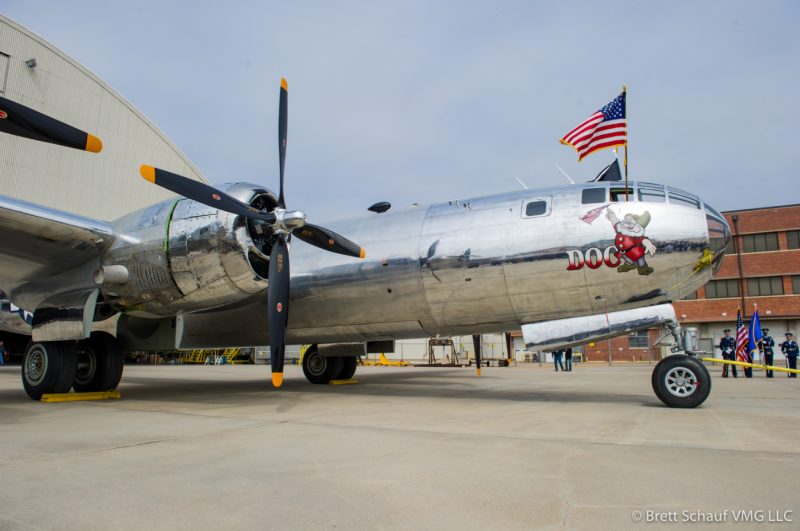On 23rd March 1945, a squadron of B-29 Superfortress bombers, some of the 1644 B-29’s built by Boeing at their Wichita plant, were delivered to the Army. The squadron, known as Snow White and the Seven Dwarfs, came into being five months before another B-29, Enola Gay, dropped the atomic bomb on Hiroshima. In July 1951, B-29 No 44-69972 – named ‘Doc’ (from the Seven Dwarfs) – and sporting the cartoon character painted on its nose, was working on radar calibration. A few years later, in May 1955, Doc was used to tow targets and sadly a month afterwards this plane, along with the rest of her squadron, was grounded at China Lake in the Mojave Desert where they were used as target practice by the Navy.
42 years later she caught the eye of Tony Mazzolini, who set about trying to purchase the old lady from the military, with the intention to have her restored to flying status to serve as a living museum. Twelve years later, in April 1998, Mazzolini and his team eventually managed to rescue Doc and she was towed out of the desert. Nature and explosives had taken a toll on the craft and after being inspected by an expert, the magnitude of the project was revealed.
In May 2000, Doc was shipped back to her place of birth in Wichita, in pieces, and an army of volunteers assembled to start the restoration process. Some of the volunteers were originally employed at Boeing’s Wichita plant when Doc was originally built, others served as crew members on B-29’s during the war years and some were past and present employees of Spirit AeroSystems.
Inevitably this was a laborious and expensive business and in February 2013 a group of aviation enthusiasts led by Jeff Turner, the retired CEO of Spirit AeroSystems, formed Doc’s Friends, a non-profit organisation, to drive the project of getting this lady back into the air.
Excitement abounded on Wednesday 11th May, 2016 when a big step forward was taken toward the gaining of an airworthy certificate for Doc. Two of her four 3,600 horse-power engines were run up and she slowly rolled forward under her own power at Air Capital Flight Line, which formerly housed Doc’s birth place of Boeing Wichita. The forty-five minute test was the first time she had moved under her own power for many years and the culmination of fifteen long years of rehabilitation and restoration.
Josh Wells, a spokesperson for Doc’s Friends, told The Wichita Eagle, during an interview on Thursday 12th May, “They report that it handled perfectly. When it first moved 6 inches, those guys were … unbelievably proud.” Unsurprisingly, there were “a lot of hugs, a lot of tears.”
Wells said, during the interview, that Doc had undertaken a low-speed taxi test across Air Capital’s ramp from north to south and back again at the pedestrian speed of 8-10 miles per hour. It may have been slow, but the sense of achievement and pride was evident amongst the small group of spectators. The group was deliberately kept small for safety and security reasons.
With this test safely out of the way, the restorers can move on to further tests culminating in a full airworthiness certificate issued by the Federal Aviation Administration. When that precious piece of paper is granted, Doc will again take to the skies to inspire a whole new generation of aviation enthusiasts.
The public will be advised when Doc will be officially unveiled and presented for the first time.
